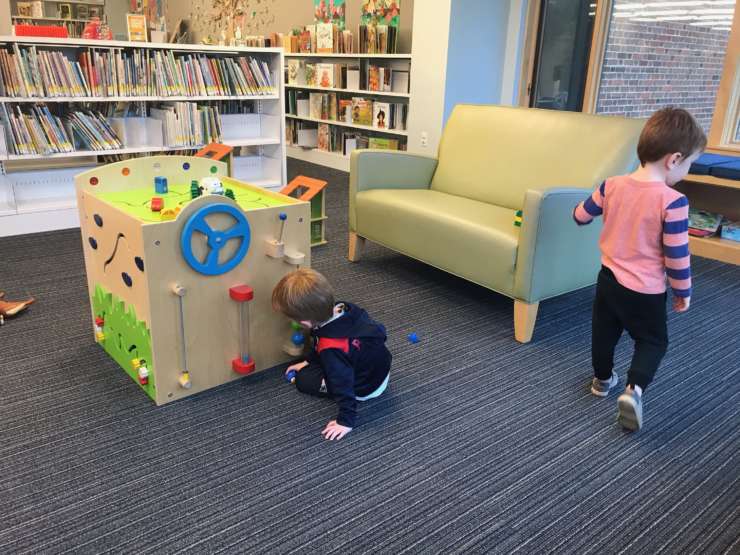Have you ever been in a rush to get somewhere and you get in the car and see that your low fuel light is on, or you know it will be sometime during the drive? If you have, and you’re like me of 15 years ago, you think to yourself, “I can make it…I don’t have time to stop for gas…I can’t be late!” Ninety percent of the times I took that daring risk, it worked out okay for me. I pulled into my location on fumes and filled up the tank as soon as I started the next journey. But in that unfortunate ten percent, I ended up on the side of the road waiting for AAA or a non-judgemental parent to come rescue me with a plastic jug of gas. And I was very late for wherever I was going, or I missed it completely. I wish I could say that only happened once, but at least it happened enough times for me to know this: I will be more late if I run out of gas than I might be if I stop to fill the tank as soon as the low fuel signal is lit.
Our days with our children are filled with transitions. A transition can be a few things. It is any change from one location to another (home to school, for example). It also can be the end of one activity and the start of the next (bath time to bed time), or the end of one period of time to another (winter vacation back to school). The transitions we notice the most, because they are the hardest, are the ones that take the child from something she likes to something she likes less–in ABA terms we’d call it transitioning from preferred to non-preferred. To add to the difficulty, we adults usually place a lot of emphasis on transitioning quickly or immediately. We have to be on time, or we have to get something else done, and we need our children to go with the plan so that we can stick with our plan.
But we all know what happens when we ask our children to hurry up, get ready, stop what they’re doing, it’s time to get to the next thing and we’re going to be late if you don’t: their low fuel signal lights up. Usually the low fuel light is some form of challenging behavior from your child, maybe some whining, refusal to do what you ask, maybe something more significant than that. The low fuel light ALSO is your stress-related feelings: increased heart rate, a feeling of stress, thoughts of “we can’t be late, I’m going to miss the appointment, why can’t anything ever be easy???”
At that point, you have two choices. You can push through and try to make it on fumes. You might yell, or coax, or just pick your child up and carry her to the car. You might do everything for your older child and plan to work on independence at a later, calmer time. You might tell yourself you’re a terrible parent and why can’t you get your act together all while you hustle your child to the car and frantically try to get to your destination on time. And yes, you might make it on time, but at what cost? You now have set yourself and your child up for the likelihood that the next transition will feel just as rushed and stressful.
Your other choice is to take the extra few minutes to fill up the tank. Give yourself and your child some resources and support to transition more smoothly. A transition is a perfect opportunity to use some good ABA tactics, and I have practiced a few with my kids with decent success (when I remember to use them). I am not guaranteeing this will get you to where you need to be on time, or that you won’t add a few minutes to your routines at home, but I do think that your calm(er) demeanor, fewer challenging behaviors, or some great skills practiced all are equally good, if not better outcomes than being on time. Here are my recommendations:
*These are not to be used as a behavior plan for your child or for any other. These are general suggestions based on behavioral strategies. You always should do what is safest for you and your child, or follow a plan that has been developed by a professional for your child.*
- Take a deep breath. This is for you, the parent, and it’s not just a zen-like saying. The actual act of taking one to three deep breaths has a few benefits. First, it starts to calm your brain and body’s stress response. When we are stressed for whatever reason, our body shifts into fight or flight mode, neither of which is particularly helpful when you are trying to get yourself and your child(ren) out the door or off to bed. A deep breath or two helps to slow your heart rate and clear your mind. This breath also acts as an alternative to what might have been your first response to your child’s behavior. Instead of repeating an instruction, sighing in frustration or yelling, you are simply taking a quiet breath.
- Observe what your child is doing. Is he in the process of getting ready to go, but having a hard time remembering what to do next or finding the other shoe? Is she playing with her favorite toys? Does he appear tired or upset? This observation will help you know what your child needs or wants, which will help you know what to do next.
- Step 3 requires some creative thinking–you figure out a simple way to become part of what your child wants and needs. You dig into your ABA tool belt and get to work. Here are a few real-life examples from my household:
- With three minutes until we have to leave for the bus, my 9-year-old has no shoes on and his bag is not packed. I take that deep breath, which dissipates the “how does he not know what to do when it’s the 60th day of THIS school year?!?” thoughts, and realize that he can’t find his shoes, and he wants to get his shoes on before packing the bag. Instead of telling him what he needs to do, I ask, “What can I do to help?” He says, “Can you check if my shoes are upstairs and I’ll pack my bag?” Since this shows me he knows the routine and he can ask for help appropriately, I help him find the shoes.
- My two-year-old twins are in the bath, and I am ready to get them out so that we can move into bedtime. When I say, “Time to get out!” one twin stands up and happily allows me to wrap him in a towel. The other twin does the opposite–he lies on his belly in the water, kicks his feet and tells me, “I’m swimming!” I try to drain the water but he blocks me. Now I really want him to hurry up because his brother is getting cold waiting for him, and I want bedtime to start! Deep breath. This little boy loves his bath time–it’s a highly preferred time of day. With his brother out, he has more space to kick and splash. Rather than picking him up out of the bath before he has stood up to show he’s ready (which is less safe for me and for him and also takes away the opportunity for him to follow an age-appropriate direction), I say, “Wow, you’re a good swimmer! Can you do ten more kicks for me?” He complies, vigorously. Then I say, “Great swimming! Now stand up!” He complies again! This is the ABA strategy of behavioral momentum, gaining compliance with an instruction he is likely to follow (swimming in the tub) and moving quickly to an instruction he is less likely to follow. Both twins now are out of the tub, snuggled in towels, and ready for pajamas and our bedtime routine.
- None of my kids like to leave the playground, and it is a massive strategic effort to get all five safely to the car within anything that could be considered a reasonable amount of time. Once, a team of creative babysitters promised to get the family a pet fish if the kids would exit the playground. They responded to that, and the sitters followed through, but, for obvious reasons, I cannot use that tactic every time (or ever again). I take a deep breath and rally the troops with “Okay, we’re going to race to the gate! On your mark, get set, go!” The older three are motivated by their competitive drive to race each other to the gate. I take the twins by their hands and ask them, “Should we run or jump to the gate?” I have made the transition itself more reinforcing for the older kids, and by offering a choice within the transition to the toddlers, they too can tell me something they want to do even when leaving the playground is not what they want to do! We all make it to the car and I don’t have to add any pets to the family. Success!
Being on time is great, staying on a plan or routine is helpful and important, but neither of those outcomes should happen at the expense of your or your children’s stress or frustration. We might think that pushing through when that low fuel signal lights up is worth the risk, but the extra time it takes to refuel might save you a lot of hardship if your risk doesn’t pan out. Keep building and practicing those ABA tactics that help you and your child, don’t worry about the extra time it might take. Deep breath, refuel, and get there when you can.






Comments (0)